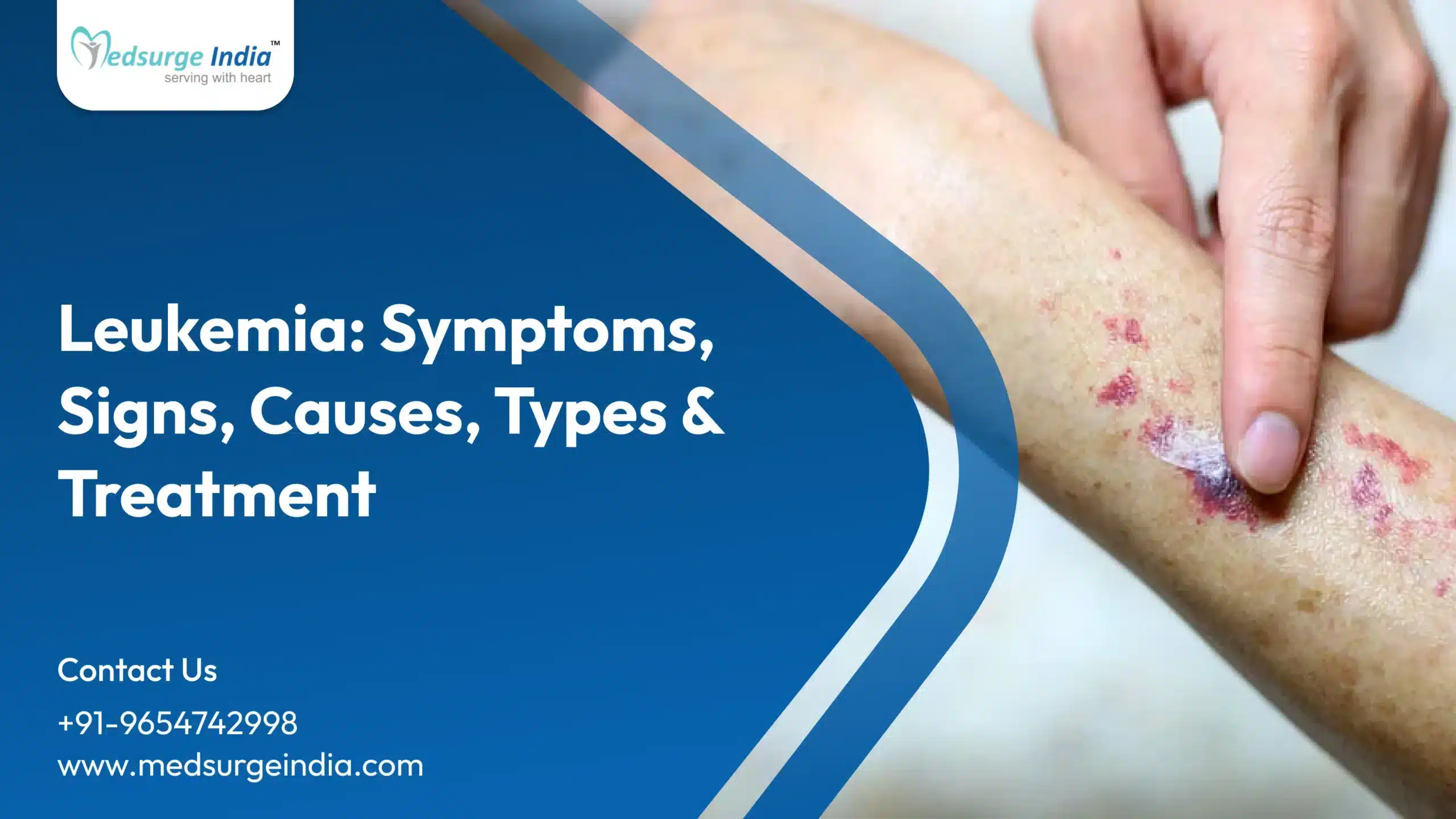
Leukemia: Symptoms, Signs, Causes, Types & Treatment
Leukemia, a complex group of blood cancers, occurs in the bone marrow—the body’s blood-forming tissue. It is considered one of the most common blood cancers worldwide, primarily affecting children, but adults and older individuals are also at risk.
Leukemia happens when the bone marrow makes too many abnormal white blood cells, which crowd out healthy cells and disrupt normal blood function. However, other blood cells, such as red blood cells or platelets, can also be affected depending on the type of leukemia.
Classification of Leukemia
Leukemia is classified based on either the speed of progression or the type of blood cells affected:
Speed of Progression
- Acute Leukemia: A life-threatening condition that affects children the most. The progression of the leukemia is rapid; thus, it requires the immediate initiation of therapy. This may cause you to feel unwell just weeks after it begins.
- Chronic Leukemia: In contrast, chronic leukemia progresses more slowly than acute leukemia. And if you have chronic leukemia, it may remain unnoticed or undiagnosed for several years.
Types of Blood Cells
- Myelogenous or Myeloid Leukemia: Myeloid cells, which develop into red blood cells, certain white blood cells, and platelets, are affected.
- Lymphocytic Leukemia: This mainly affects lymphoid cells that normally develop into white blood cells, a major part of your immune system.
Types of Leukemia
Some of the major types of leukaemia are:
- Acute lymphocytic leukemia (ALL): ALL can spread to lymph nodes and the central nervous system (CNS). More commonly occurring in children and young adults. But it can also occur in adults.
- Acute myelogenous leukemia (AML): AML, the most common type of leukemia in adults, although it can also affect children.
- Chronic lymphocytic leukemia (CLL): CLL mainly affects adults. It can grow slowly and remain unnoticed for several years.
- Chronic myelogenous leukemia (CML): It’s a slow-progressing type of leukemia where symptoms may not be visible in their early stages.
Other types of leukemia
Some of the rare leukemias include myelodysplastic syndromes, hairy-cell leukemia, and myeloproliferative disorders.
Signs & Symptoms of Leukemia
Symptoms vary depending on the type of leukemia. Furthermore, if you have chronic leukemia, the symptoms may remain unnoticed during the early stage of the cancer.
Common symptoms include:
- Persistent fatigue or weakness
- Frequent or unexplained fevers
- Recurrent infections
- Easy bruising or bleeding (e.g., nosebleeds, bleeding gums)
- Unexplained weight loss
- Swollen lymph nodes (especially in the neck or armpits)
- Bone or joint pain
- Excessive sweating, especially at night (night sweats)
- Pale skin (anemia)
- Shortness of breath
- Tiny red spots on the skin (petechiae)
- Abdominal discomfort or fullness (due to enlarged spleen or liver)
- Loss of appetite
Do Leukemia Signs Vary Between Men and Women?
Generally, the signs and symptoms of leukemia are similar in both men and women. However, women may sometimes experience additional or more noticeable symptoms related to their reproductive health. These can include:
- Heavy or irregular menstrual bleeding
- Unexplained vaginal bleeding
- Pelvic pain or discomfort
What are the Causes of Leukaemia?
Leukemia is caused by genetic mutations in blood-forming cells, which lead to uncontrolled cell growth. However, the exact cause of leukaemia is unknown; still, certain risk factors may contribute to increasing the likelihood of leukaemia occurrence.
- Long-term exposure to chemicals like benzene
- Smoking
- Previous chemotherapy or radiation therapy
- Exposure to high levels of radiation
- Genetic disorders (e.g., Down syndrome, Li-Fraumeni syndrome)
- Family history of leukaemia
- Weakened immune system
- Male gender (higher risk in some types)
- Older age (certain leukemias are more common in adults)
Diagnosis of Leukemia
The following are diagnoses required for leukemia:
- Physical examination: During a physical exam, your doctor may check for signs of leukemia. This includes skin rashes, gum bleeding, swollen lymph nodes, and enlargement of the spleen or liver.
- Blood tests: Several blood tests are done to see the abnormal red blood cells, white blood cells, and platelets. Also, if you have leukemia, you may have a higher white blood cell count.
- Bone marrow biopsy: The biopsy is done to confirm leukemia and also to determine the percentage of abnormal cells present. This is done by inserting a thin, long needle into the bone marrow and drawing out fluid to examine the leukemia cells.
- Imaging tests: Several imaging tests, such as chest X-ray, CT scan, and MRIs, are performed to confirm if the cancer has also affected the bones, organs, and tissue.
- Lumbar puncture: Your spinal fluid is also examined to see if leukemia has spread to the brain or spinal cord.
It is always advised to undergo a routine blood test to avoid any unexpected health issues early. Also, your doctor may suspect any of the signs of leukemia through one or more of the above-given tests.
Also Read: Bone Marrow Transplant For Leukemia in India
Treatment Available for Leukemia
Based on the type of leukemia, different treatments are recommended by your doctor. To completely eradicate the cancer, either a single treatment or a combination of treatments is given.
The following are the types of treatments available for leukemia:
- Chemotherapy: The most commonly used treatment for leukemia, where powerful medication is given to kill the cancer cells. This can be given either through a pill, intravenous injections, or in the form of a shot under your skin.
- Radiation therapy: In this treatment, a strong energy beam or X-rays is used to target the cancer cells. This can be given either to a specific affected area or to your whole body, based on your cancer situation.
- Immunotherapy: Certain strong drugs are used to boost your immune system, which can identify and kill the cancerous cells.
- Targeted Therapy: In this treatment, drugs or other substances are used to precisely identify and attack cancer cells while minimizing damage to normal, healthy cells.
- Stem cell or Bone marrow transplant: Bone Marrow Transplant is performed by replacing damaged or diseased bone marrow with healthy stem cells. This can be either through an autologous or an allogenic method. BMT is commonly used for aggressive or relapsed leukemia. It helps restore the body’s ability to produce healthy blood cells.
- CAR T-cell therapy: CAR T-cell therapy is an advanced immunotherapy that uses the patient’s own genetically modified T-cells to target and kill leukemia cells. It is especially effective in relapsed or treatment-resistant B-cell leukemias.
Also Read: Chemotherapy For Acute Lymphocytic Leukemia
What are the Phases of Leukemia Treatment?
The treatment is provided in three phases.
- Induction therapy: A first phase of treatment where the goal is to kill as many cancer cells as possible to achieve remission. This phase lasts for four to six weeks.
- Consolidation therapy: It is usually given in cycles over four to six months. The goal is to eliminate any remaining leukemia cells after remission and reduce the risk of relapse.
- Maintenance therapy: Maintenance therapy is a long-term, lower-intensity treatment given after consolidation to help prevent relapse and keep the leukemia in remission. It may continue for months or even years.
Recovery from Leukemia Treatment
The recovery from leukemia treatment requires time and careful management, and this varies with the type of treatment received. Supportive care, proper nutrition, and regular follow-ups are essential during recovery.
Emotional and psychological support is also important, as the journey can be physically and mentally challenging. With time, many patients regain strength and resume normal activities, but ongoing care is vital to detect any signs of relapse early.
Takeaway
Leukemia can affect anyone, from children to adults to older individuals. Early diagnosis is vital since symptoms may be subtle. If you experience unexplained fatigue, frequent infections, or easy bruising, don’t wait—consult your doctor right away. Fortunately, India offers a wide range of cutting-edge treatments, providing patients powerful options to fight and manage leukemia effectively.










